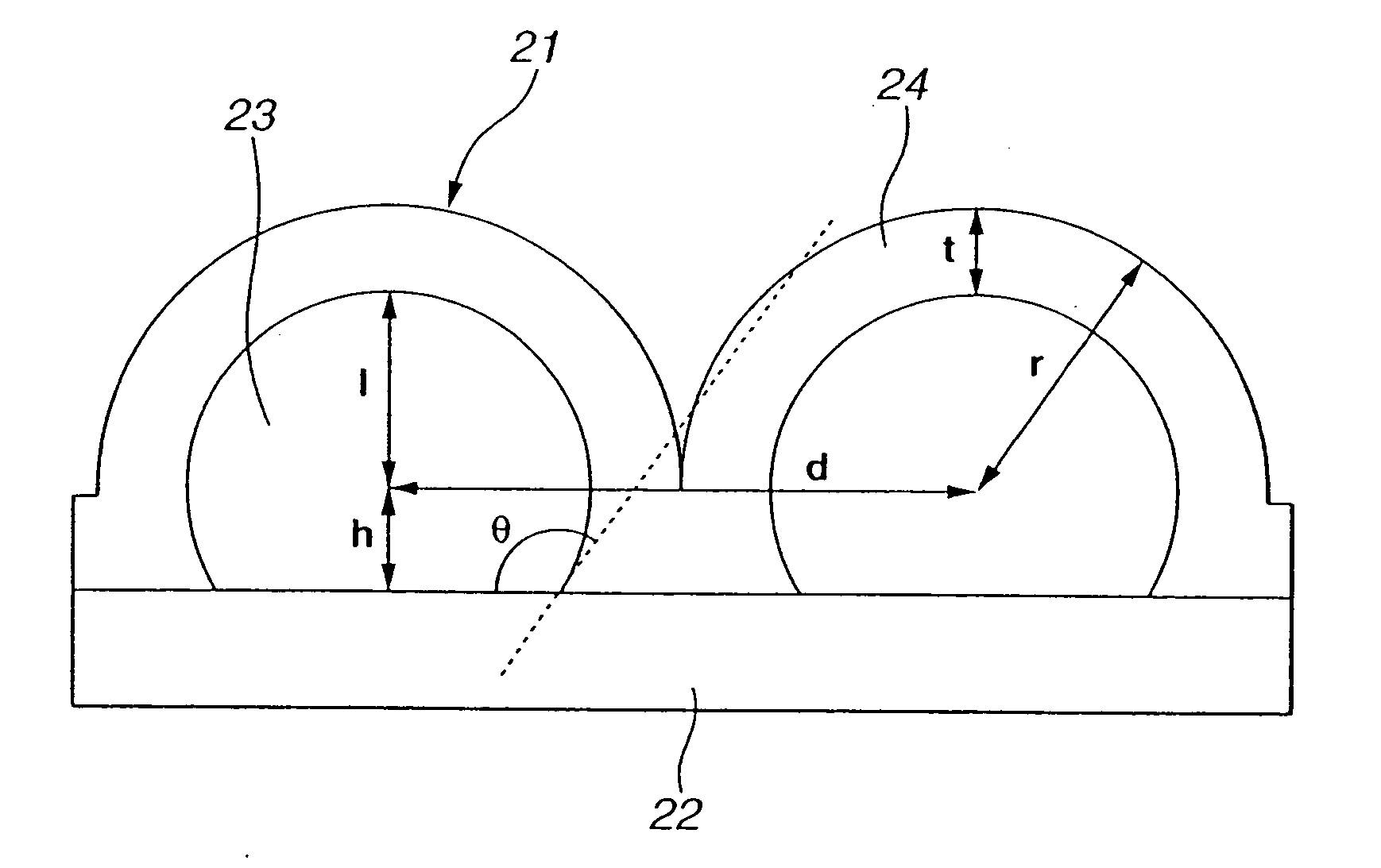Microstructure array, mold for forming a microstructure array, and method of fabricating the same
a microstructure array and microstructure technology, applied in the field of microstructure arrays, can solve the problems of difficult design of lenses with large na, difficult fabrication of large-area microstructure arrays, and inability to large-scale microstructure arrays, etc., to achieve convenient control of profile, reduce unusable regions, and facilitate fabrication
- Summary
- Abstract
- Description
- Claims
- Application Information
AI Technical Summary
Benefits of technology
Problems solved by technology
Method used
Image
Examples
third embodiment
[0068] In the third embodiment, on a silicon wafer 1 with a diameter of four inches, a positive photoresist is spin-coated to a thickness of 8 μm to form a thermoplastic resin layer 2, as illustrated in FIG. 1A.
[0069] Thereafter, 1064×808 square resist microstructures 2 with sides of 16 μm are formed at common intervals of 2 μm using semiconductor photolithography, as illustrated in FIG. 1B. At the same time, a pattern for an alignment marker is formed at a desired position outside a region of the array of the resist microstructures 2.
[0070] The substrate 1 is then baked at a temperature of 150° C. for fifteen (15) minutes. The thermoplastic resin layers 2 including the pattern for the alignment marker hence undergo reflow, and spherical resin layers 2 are formed as illustrated in FIG. 1C.
[0071] Cr and Au are then continuously layered to thicknesses of 50 Å and 1000 Å on the above wafer, respectively, using an electron-beam evaporation method. An electrode layer is thus formed. Ni...
sixth embodiment
[0098] In this embodiment, a mold for a microlens array and a convex microlens array can be fabricated, in a manner similar to the The thus-fabricated microlens array also satisfies the relationship r=d / 2=12.7 μm, and each microlens has an exactly-semispherical profile.
[0099] An eighth embodiment of the present invention will be described with reference to FIGS. 3, 4A, and 4C. In the eighth embodiment, on a silicon wafer 22 with a diameter of two inches, 1024×768 spherical microstructures 23 are formed at common intervals of 18 μm. An Ni electroless nickel plated layer 24 is formed on the silicon substrate 22 and the microstructures 23. The electroless plated layer 24 is a continuous layer that is isotropically grown.
[0100] In this embodiment, the radius l of the spherical microstructure 23 is 8.5 μm, the height h between the center of the spherical microstructure 23 and the substrate 22 is 4.2 μm, and the angle θ of contact between the spherical microstructure 23 and the substrat...
eleventh embodiment
[0113] the present invention will be described. In the eleventh embodiment, a quartz substrate of 24 mm×38 mm is spin-coated with a layer of polyamic acid to a thickness of 12 μm. A polyimide layer is formed by baking the wafer. A layer of aluminum (Al) is then formed by an electron-beam vacuum evaporation. A photoresist is then coated. Thereafter, 1064×808 cylindrical Al microstructures are formed at common intervals of 18 μm using semiconductor photolithography.
[0114] The polyimide layer is etched by reactive ion etching using the pattern of Al microstructures as a mask. Thus, 1064×808 cylindrical polyimide microstructures are formed at common intervals of 18 μm.
[0115] The substrate is then baked at a temperature of 450° C. for fifteen (15) minutes. The polyimide layers hence undergo reflow, and spherical layers are formed. Here, the angle of contact between the spherical resin layer and the substrate is 120 degrees. The radius l of the spherical microstructure is 8.5 μm, the hei...
PUM
| Property | Measurement | Unit |
|---|---|---|
| Angle | aaaaa | aaaaa |
| Microstructure | aaaaa | aaaaa |
| Area | aaaaa | aaaaa |
Abstract
Description
Claims
Application Information
 Login to View More
Login to View More - R&D
- Intellectual Property
- Life Sciences
- Materials
- Tech Scout
- Unparalleled Data Quality
- Higher Quality Content
- 60% Fewer Hallucinations
Browse by: Latest US Patents, China's latest patents, Technical Efficacy Thesaurus, Application Domain, Technology Topic, Popular Technical Reports.
© 2025 PatSnap. All rights reserved.Legal|Privacy policy|Modern Slavery Act Transparency Statement|Sitemap|About US| Contact US: help@patsnap.com



